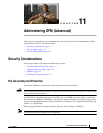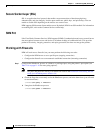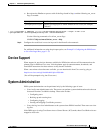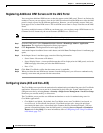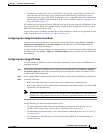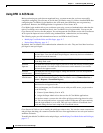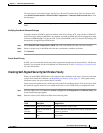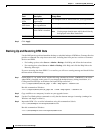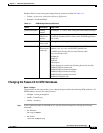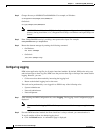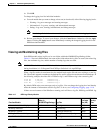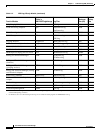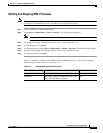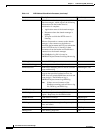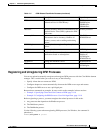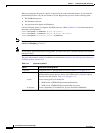
11-9
User Guide for Device Fault Manager
OL-11390-01
Chapter 11 Administering DFM (Advanced)
System Administration
Database files are stored using the backup directory structure described in Table 11-1.
• Format—/generation_number/suite[/directory]/filename
• Example—/1/dfm/dfmFh.db
Changing the Password for DFM Databases
Before You Begin
The procedure in this topic enables you to change the password for the following DFM databases. All
DFM databases must use the same password.
• dfmEpm—Event promulgation
• dfmFh—Fault History
• dfmInv—Inventory
Step 1 At the command prompt on the DFM server, stop the daemon manager by entering the following
command:
• On Windows:
net stop crmdmgmt
• On Solaris:
/etc/init.d/dmgtd stop
Table 11-1 DFM Backup Directory Structure
Option Description Usage Notes
generationNumber Backup
number
For example, 1, 2, and 3, with 3 being the latest database backup.
suite Application,
function, or
module
When you perform a backup, data for all suites is backed up. The
CiscoWorks Common Services suite is cmf.The DFM application
suite is dfm.
directory What is
being stored
Suite applications (if applicable).
filename Specific file
that has been
backed up
Files include database (.db), log (.log), version (DbVersion.txt),
manifest (.txt), tar (.tar), and data files (datafiles.txt).
For DFM, the following files are listed directly under
generationNumber/suite:
dfmEpm.db
dfmInv.db
dfmFh.db
filebackup.tar
The file backup.tar contains the following directories and file:
NMSROOT/objects/smarts/conf
NMSROOT/objects/smarts/local/repos
NMSROOT/objects/smarts/local/logs
NMSROOT/objects/smarts/local/conf
NMSROOT/setup/dfm.info



